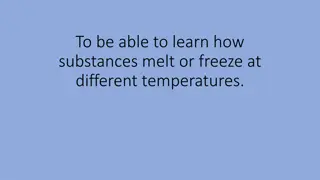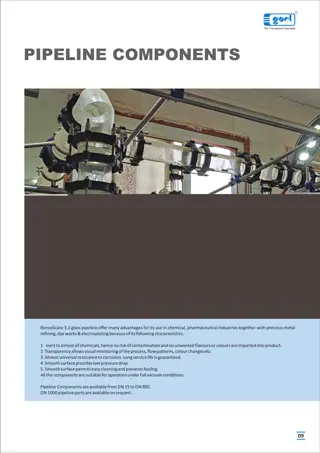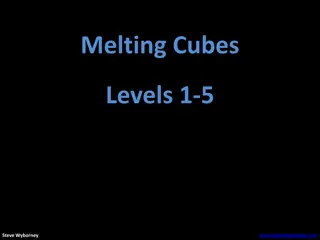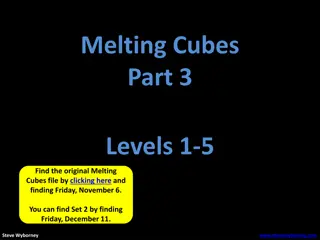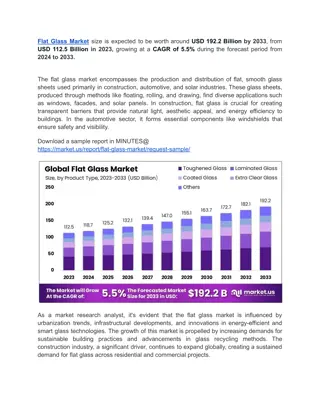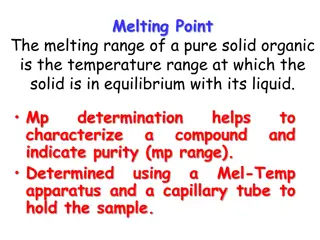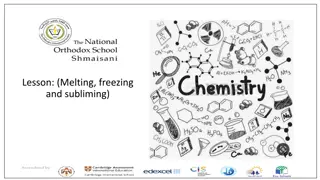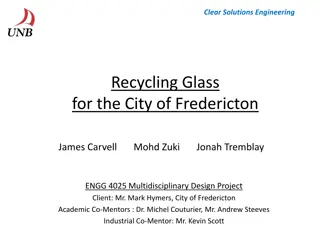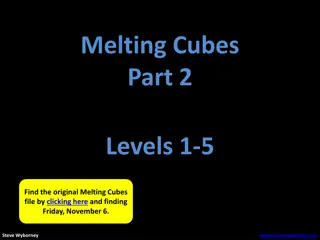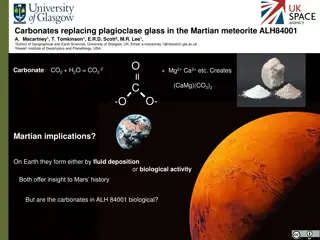Understanding the Melting Process of Glass
The melting process of glass involves introducing a batch into a furnace at high temperatures for conversion into a glass melt through various chemical reactions such as decarbonation and dissolution. Initial heating releases moisture, and gas is released during decomposition, affecting homogenization. Liquid phases form as components melt, affecting viscosity and gas solubility. Managing viscosity and dissolution lead to homogeneous glass formation, requiring precise control throughout the process.
Download Presentation

Please find below an Image/Link to download the presentation.
The content on the website is provided AS IS for your information and personal use only. It may not be sold, licensed, or shared on other websites without obtaining consent from the author. Download presentation by click this link. If you encounter any issues during the download, it is possible that the publisher has removed the file from their server.
E N D
Presentation Transcript
GLASS LECTURE 5 Melting process of Glass By Asst. Lect. Shireen Hasan
Melting process of Glass The batch is introduced in the furnace at high temperature, and the energy provided to the batch is used to convert the batch into a glass melt. The batch- to-melt conversion implies a series of chemical reactions (decarbonation, dehydration, solid-state reactions, formation of low-melting eutectics, dissolutions)
Initial heating of a glass forming batch usually results in the release of some moisture, which may have been absorbed on the particles or combined as water of hydration or as hydroxyl. The temperature at which this water is released will depend upon the nature of its bonding to the materials, i.e., physical or chemical and the strength of these bonds. Removal of this water carries heat from the batch and increases the cost of processing.
Gas is released during the decomposition of carbonates, sulfates and nitrates. The gases released expand to volumes much greater than that of the starting batch, resulting in considerable mixing and stirring action, which aids in homogenization of the melt. The creation of so much gas, however, also leads to the formation of an extremely large number of bubbles, which must be removed from the melt before processing is completed. The rapid formation of a liquid can entrap a portion of the air which initially occupies the space between particles and result in bubble formation. Rapid heating of such a melt can lead to expansion of these bubbles and foaming of the melt.
2- Formation of liquid phase Liquid phases are formed by the direct melting of batch components, by melting of decomposition products, and by melting of eutectic mixture formed from the batch components. As the temperature increase, the rates of dissolution of refractory particles such as sand, alumina and feldspars increase. The increase in concentration of these components causes a rapid increase in viscosity, and the release of additional gases as the solubility of CO, and other gases decrease with increasing silica concentration in the melt.
Since the viscosity increase rapidly as the silica content of the liquid increases, the temperature must be increased even further to keep the melt fluid enough for thorough mixing between liquid and remaining solid. The final stage of the melting process, in which the remaining silica and other refractory components are completely dissolved and the melt becomes homogeneous, occurs much more slowly due to the high viscosity of the melt. The time required to completely dissolve the original batch is known as the batch free time. the exact time for melting all of the batch component is difficult.
Other factors include overall glass composition, specific batch components used to obtain that composition, batch homogeneity, grain size of batch components, and the grain size and amount of cullet added to the batch. The use of cullet or scrap glass, not only reduces waste, but also aids in reducing batch free time by both reducing the amount or refractory material in the batch , and by providing additional liquid throughout the melting process.
The choice of batch component is also important in controlling batch- free time. Many batch components can be supplied from a variety of raw materials. Changes in particle size can seriously affect the batch free time for melts. While fine particles melt more rapidly, they can also agglomerate to form large, porous particles, which effectively prevent penetration of the viscous liquid to the particle surface. Since these agglomerations have a low bulk density, they can float to the surface of the melt, which significantly slows the dissolution process. Escape of gasses is inhibited when very fine particles are used, since the channels between the particles are reduced in size.
3- Melting accelerants The most important methods for accelerating the melting process are based on changes in the batch raw materials. Replacement of a small portion of sodium carbonate by sodium sulfate, for example, speeds the dissolution of sand by forming additional lower melting eutectic mixtures. The release of SO3creates a vigorous stirring effect which aids in homogenization of the melt, and improves the contact between silica particles and the surrounding liquid.
Other melting accelerants are also based on replacement of some of the sodium carbonate by more easily melted compounds such as NaOH, NaF, or NACl, all of which form very fluid liquids upon melting. The use of the halide will still result in a shorter batch free time.
4- volatilization of component from melts A large number of the components of glasses are quite volatile at elevated temperatures. Loss of these components can significantly alter the composition of the glass obtained after prolonged melting, as compared to that obtained for short melting times. Volatilization losses are particularly significant for alkali oxides, lead, boron, phosphorus, halides and other components which have high vapor pressures at high temperatures.
5-Melting reactions 1- De-hydration of some raw materials and water evaporation. It Takes place at 100 C for physically bonded water. Dehydration (water evaporation) is very energy intensive, and it is represents an important part of the total energy consumption. 2- Solid state reactions between individual raw materials. It can be divided into two routes: the carbonate route and the silicate route
The carbonate route (path) is characterized by reactive dissolution of silica sand with a binary melt phase of soda ash and limestone below about 900 C. Soda ash and limestone, in contact with each other, may form a double carbonate by a solid state reaction forming the species Na2Ca(CO3)2. At about 820 C, this intermediate reaction product starts to melt and becomes suddenly more reactive (better contact) towards silica sand grains. The silica/silicate route is based on eutectic melting of a mixture of components, including the sodium disilicate phase, formed by solid state reactions between sand and soda. The eutectic melting of SiO2 and Na2O 2SiO2 takes place at 799 C and silicate rich melts are formed.
3- Formation of primary melt phases and melting of alkali rich carbonates. (typically in the temperature range: 700-900 C) 4- Dissociation or decomposition reactions of Ca- and Mg- containing carbonates (e.g. limestone and dolomite), resulting in development of CO2-gas. (Temperature range 500-1000 C) (Na2CO3 will not decompose spontaneously, but reacts with sand or limestone). 5-Dissolving of the SiO2 in the alkali rich carbonate melt phases, typically above 1000 C. Sand reacts between about 750-1000 C with sodium silicates or soda to form liquid sodium silicates (associated with the release of CO2-gas when limestone or soda or dolomite is reacting with sand)
Sand dissolution is a critical step in industrial melting process. It is highly dependent on the initial grain size distribution of the sand grains in the batch, as well as the presence of aggressive molten phases (e.g. alkaline phases). Sand grains react with other batch components or dissolve in the obtained melt in most glass melting processes. The optimum grain size depends on the glass type.
5- THE FINING PROCESS Bubbles in the final product are undesirable, because they diminish the optical quality and decrease the strength of the glass product. Therefore, the bubbles must be removed from the melt. This is done during the so- called fining process. even in a melt which previously seemed plain, bubbles can appear. This is called reboil. The origin of reboil bubbles lies in in homogeneities in the melt or a sudden increases in temperature. In order to prevent reboil, not only the bubbles should be removed during the fining process, but also as much of the physically and chemically dissolved gases as is possible. This will lower the chance of supersaturation.
The fining process can be divided into two stages: - The first stage, or primary fining, occurs at high temperatures. Because the chemical solubility of most gases decreases, gases are released in the melt. Especially if chemical fining agents are added to the batch, large amounts of fining gas will be generated. The melt becomes supersaturated with these gases. The gases diffuse to existing bubbles or form new ones. During this stage, small bubbles grow by taking up fining gases from the melt. Other gases, initially present in the bubble, will be diluted. This enhances the driving force for transport of these gases into the bubbles.
This the fining of glass melts effect is even more significant because the surface area of the bubbles increases during bubble growth. The increased bubble ascension rate provides for a fast replacement of the melt at the surface of the bubble. As a matter of fact, chemical fining agents aid the degassing of the glass melt at high temperatures because of the low melt viscosity and high gas diffusivities.
- The second stage, or "refining", takes place at lower temperatures, at the end of the glass tank (also called "refiner"). The remaining bubbles predominantly contain fining gases. Since the chemical solubility of these gases increase at decreasing temperature, the fining agents react with the fining gases from the bubbles. The partial pressures of the other gases in the bubbles increase. The melt contains hardly any gases at this point of the fining process, and may be able to take up the gases. The bubbles shrink and may even disappear completely. So, at low temperatures, the chemical fining agents enhance the resorption of small bubbles.


